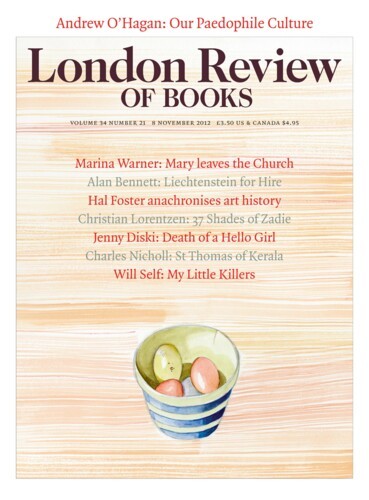Born in 1759, Carl Wilhelm Kolbe worked as a teacher before the declining fortunes of his school prompted him to train as an artist. He went to the Berlin Academy of Art, a man in his thirties among boys of twelve. Even more unusually, Kolbe produced nothing but etchings, some of which are currently on display at the British Museum, along with other German Romantic prints and drawings from the collection of Charles Booth-Clibborn, the founder of the Paragon Press.
Alice Spawls
Alice Spawls is co-editor of the LRB.
As the first signs of autumn began to appear last week I went horseriding with my sister in Trent Park, just north of London. It's mostly woodland, and for a lot of the time you can go without hearing or seeing another person, or car or any sign of modernity, even though it’s only a couple of miles from the M25. When you’re alone you can ride as fast as you like, which is to say as fast as you can, feeling the earth kicked up behind you, the forest a blur, the burn of little branches whipping you in the face. The horses we ride are only stable cobs, but the fantasy horse is always an Arabian.
Pleased to Be Loony: The Janeites
Alice Spawls, 8 November 2012
Claudia Johnson begins with a ghost story. One summer morning, as she sat by the leaded gothic windows of her Princeton study editing the Norton Critical Edition of Mansfield Park, she was stumped about where a comma ought to go. In the second sentence of the eighth chapter there is a discrepancy between the first and second edition of the novel: did Mr Rushworth’s mother come ‘to...
Small pictures, especially works on paper, sit more comfortably in the intimate proportions of a house than in a lofty gallery hangar, and the exhibition of watercolours and etchings by Giorgio Morandi at the Estorick Collection (until 7 April) is a well-turned example of what can be done with such an arrangement: the pictures are allowed to speak for themselves.
Kurt Schwitters was 53 when he arrived in Britain in 1940. The Nazis had labeled him an ‘Entarteter Künstler’ (degenerate artist); in Britain he was an enemy alien, locked up in Hutchinson Internment Camp on the Isle of Man: brown walls, grey tiles, grey Irish Sea. The first room of Schwitters in Britain (at Tate Britain until 12 May) gives a glimpse of his life before exile. Schwitters hovered butterfly-like on the fringes of the major European isms of the 1920s: a bit of Dada here, a bit of De Stijl there. The geometry of Ja-was? Bild, with its strips of corrugated cardboard like sign posts in a blast of blue-green abstraction, makes dramatic use of a Suprematist grammar.
Read anywhere with the London Review of Books app, available now from the App Store for Apple devices, Google Play for Android devices and Amazon for your Kindle Fire.
Sign up to our newsletter
For highlights from the latest issue, our archive and the blog, as well as news, events and exclusive promotions.


